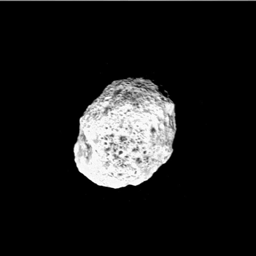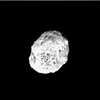
|
Encountering Hyperion (Movie)
- Click the image above for a larger view
 Movie Download Options
Movie Download Options- Full-Res JPEG (800 x 800) (28.5 kB)
- Full-Res TIFF (800 x 800) (640.9 kB)
Caption:

Quick Time Movie for PIA06243 Cassini's First Close Brush with Hyperion (Animation)
This movie sequence provides the record of Cassini's first close brush with Hyperion, Saturn's chaotically tumbling moon. As the spacecraft whizzes past, Hyperion's unusual shape is most apparent. The jagged outlines are indicators of large impacts chipping away at Hyperion's shape as a sculptor does to marble.
Hyperion's unusual dimensions are 328 by 260 by 214 kilometers (204 by 162 by 132 miles).
These Cassini images are the best views yet of one of the large, low-density objects that orbit Saturn. Hyperion is close to the size limit where, like a child compacting a snowball, internal pressure due to the moon's gravity will begin to crush weak materials like ice, closing pore spaces and eventually creating a more spherical shape.
However, this moon has a very irregular shape and preliminary estimates of its density show that it is only about 60 percent as dense as solid water ice. This suggests that much of its interior (40 percent or more) must be empty space.
The low density further suggests that Hyperion is mostly made of water ice, with a low rock and metal content. If the moon had significant higher density components, its implied porosity would be significantly higher than 50 percent. The dark material on the surface is therefore likely a minor component, possibly originating from impacts of dark material, as seen on Iapetus.
Hyperion's elliptical orbit and irregular shape influence its chaotic tumbling. Further, because it is in a resonance orbit with the giant moon Titan, impact debris ejected with sufficient energy does not come to rest again on Hyperion. Instead, debris is tugged gravitationally into Titan's orbit, where it impacts the large smoggy moon.
This series of 25 images was taken over a period of nearly two and a half days, between June 9 and June 11, 2005, as Cassini's orbit took it close to Hyperion.
Cassini will have one close, targeted flyby of Hyperion on September 26, 2005.
At the beginning of the movie Cassini was approximately 815,000 kilometers (506,000 miles) from Hyperion; at the end, the spacecraft was 327,000 kilometers (203,000 miles) distant. The closest image was acquired from a distance of 168,000 kilometers (104,000 miles). The images were taken using the narrow-angle camera and a spectral filter sensitive to ultraviolet wavelengths centered at 338 nanometers. Image scale ranges from 5 kilometers (3 miles) per pixel at most distant to 1 kilometer (0.6 mile) at best. The images have been enhanced to improve the visibility of surface features.
A stereo (3D) version of the image from this encounter is also available (see PIA06244 ).
Background Info:
The Cassini-Huygens mission is a cooperative project of NASA, the European Space Agency and the Italian Space Agency. The Jet Propulsion Laboratory, a division of the California Institute of Technology in Pasadena, manages the mission for NASA's Science Mission Directorate, Washington, D.C. The Cassini orbiter and its two onboard cameras were designed, developed and assembled at JPL. The imaging team is based at the Space Science Institute, Boulder, Colo.
For more information about the Cassini-Huygens mission visit http://saturn.jpl.nasa.gov . For additional images visit the Cassini imaging team homepage http://ciclops.org .
Cataloging Keywords:
| Name | Value | Additional Values |
|---|---|---|
| Target | Hyperion | Iapetus, Saturn, Titan |
| System | Saturn | |
| Target Type | Satellite | Planet |
| Mission | Cassini-Huygens | |
| Instrument Host | Cassini Orbiter | |
| Host Type | Orbiter | |
| Instrument | Imaging Science Subsystem (ISS) | |
| Detector | Narrow Angle Camera | |
| Extra Keywords | Grayscale, Impact, Movie, Rotation, Ultraviolet, Visual, Water | |
| Acquisition Date | ||
| Release Date | 2005-07-11 | |
| Date in Caption | 2005-06-11 | 2005-09-26 |
| Image Credit | NASA/JPL/Space Science Institute | |
| Source | photojournal.jpl.nasa.gov/catalog/PIA06243 | |
| Identifier | PIA06243 | |
